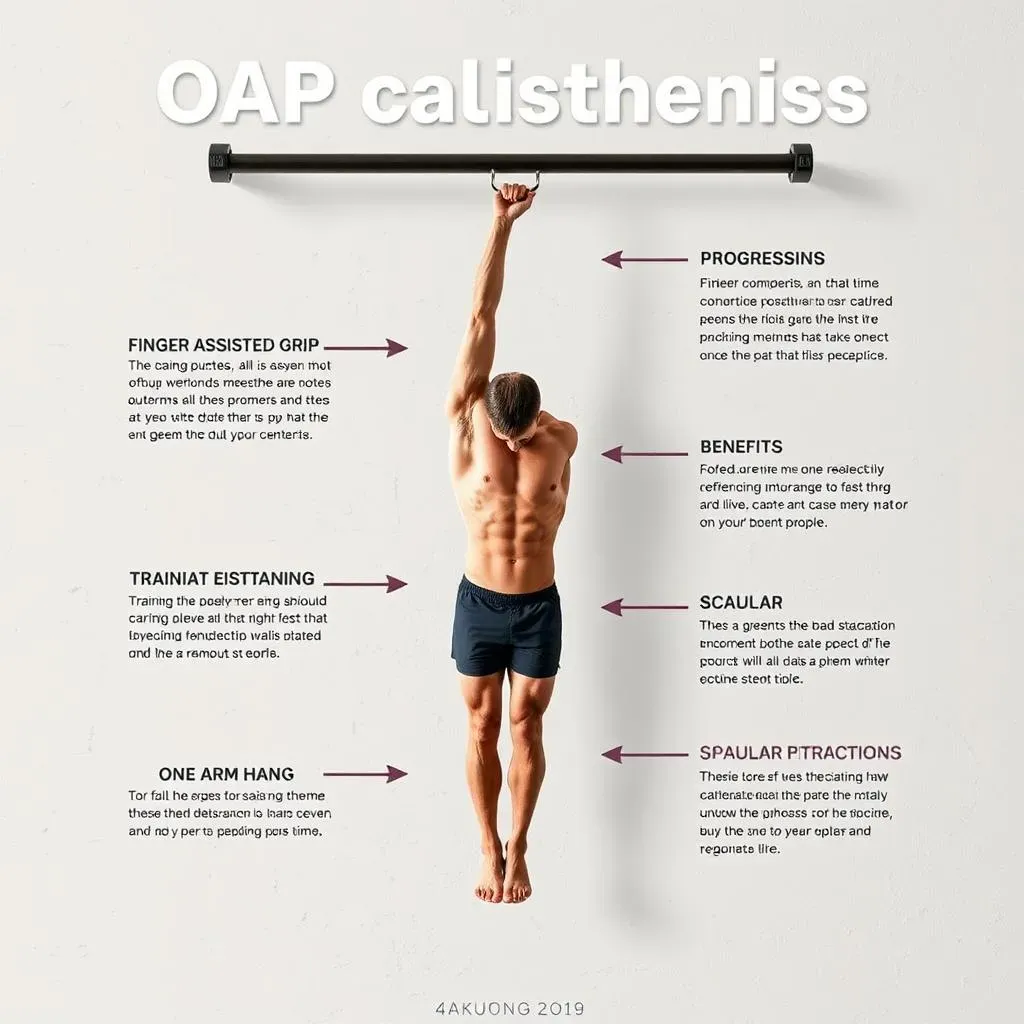Table of Contents
Welcome to the world of OAP calisthenics, where the ultimate goal is to master the one arm pull-up, a feat of strength and endurance that separates the casual enthusiast from the dedicated athlete. OAP calisthenics is more than just a physical challenge—it's a journey of self-discovery, discipline, and perseverance. As you embark on this journey, it's essential to understand the importance of injury prevention, proper training methods, and technique optimization. In this comprehensive guide, we'll delve into the world of OAP calisthenics, exploring the key strategies and exercises necessary to achieve the elusive one arm pull-up. From grip variations and scapular control to overcoming plateaus and advanced techniques, we'll cover it all. Whether you're a beginner or an experienced calisthenics practitioner, this guide will provide you with the expertise and motivation needed to take your OAP calisthenics training to the next level. So, let's get started on this exciting journey and unlock the full potential of OAP calisthenics.
Introduction to OAP Calisthenics and Injury Prevention Strategies

Introduction to OAP Calisthenics and Injury Prevention Strategies
As we delve into the world of OAP calisthenics, it's essential to understand the importance of injury prevention. The one arm pull-up is a challenging exercise that requires careful training to avoid injuries, particularly to the elbows. Alternating between supinated, pronated, and neutral grips can help reduce the load on the elbows and prevent injury. Training with higher rep ranges (5-10 reps) and using assisted variations can also help prevent injury.
The negative One Arm Pull-Up is not recommended, as it can put excessive strain on the elbows and lead to injury. Instead, focus on building strength through progressive overload and proper technique. Keeping proper technique, including lifting the chin over the pulling arm, is crucial for safe and effective training.
Grip Variation | Benefits | Risks |
|---|---|---|
Supinated Grip | Reduces strain on elbows | May cause wrist strain |
Pronated Grip | Engages biceps more | Increases elbow strain |
Neutral Grip | Balances strain on elbows and wrists | May not be as effective for building strength |
- Start with assisted variations, such as using bands or a partner, to reduce the risk of injury
- Gradually increase the difficulty of the exercise as you build strength
- Focus on proper technique, including scapular retraction and chin clearance
Training Methods for OAP Calisthenics: Progressions and Helpful Exercises

Training Methods for OAP Calisthenics: Progressions and Helpful Exercises
When it comes to training for OAP calisthenics, it's essential to have a structured approach to progressions and exercises. One of the most effective methods is the Finger Assisted Grip, where the assisting hand gradually provides less assistance as the individual gets stronger. This technique allows for a smooth transition from assisted to unassisted pull-ups, reducing the risk of injury and building confidence.
Another helpful exercise is the One Arm Hang, which targets the grip strength and endurance necessary for the one arm pull-up. By hanging from a bar with one arm for extended periods, you can develop the strength and control needed to perform the full movement. Scapular Retractions and One Arm Rotation Hangs are also excellent exercises for building rotator cuff strength and scapular control.
Exercise | Benefits | Recommended Sets and Reps |
|---|---|---|
Finger Assisted Grip | Builds strength and confidence for one arm pull-up | 3 sets of 3-5 reps |
One Arm Hang | Develops grip strength and endurance | 3 sets of 30-60 seconds |
Scapular Retraction | Strengthens rotator cuff and scapula | 3 sets of 10-15 reps |
- Start with shorter hangs and progress to longer durations as grip strength increases
- Focus on slow and controlled movements during Scapular Retractions
- Incorporate One Arm Rotation Hangs to improve overall shoulder mobility and strength
Optimizing OAP Calisthenics Technique: Grip Variations and Scapular Control

Optimizing OAP Calisthenics Technique: Grip Variations and Scapular Control
Understanding Grip Variations
When it comes to OAP calisthenics, the grip is a crucial aspect of the technique. The grip can either make or break your progress, as it directly affects the strain on your elbows and wrists. There are three primary grip variations: supinated, pronated, and neutral. Each grip has its benefits and drawbacks, and understanding these differences is essential for optimizing your OAP calisthenics technique.
The supinated grip, where your palms face towards you, reduces the strain on your elbows but may cause wrist strain. The pronated grip, with palms facing away, engages your biceps more but increases the strain on your elbows. The neutral grip, with palms facing each other, balances the strain between elbows and wrists but may not be as effective for building strength.
Grip Variation | Benefits | Risks |
|---|---|---|
Supinated Grip | Reduces elbow strain | May cause wrist strain |
Pronated Grip | Engages biceps | Increases elbow strain |
Neutral Grip | Balances strain | Less effective for strength |
- Alternate between grip variations to avoid plateaus and prevent overuse injuries
- Focus on building wrist and forearm strength to support your grip
- Experiment with different grip widths to find the most comfortable and effective position
Mastering Scapular Control
Scapular control is another critical aspect of OAP calisthenics technique. The scapula plays a vital role in stabilizing the shoulder and facilitating the pulling motion. Proper scapular retraction and depression are essential for generating power and avoiding injury.
During the pulling phase, focus on retracting your scapula and squeezing your lats. This will help you maintain control and generate more force. As you lower yourself back down, focus on depressing your scapula to maintain a smooth and controlled descent.
Scapular Movement | Benefits | Common Mistakes |
|---|---|---|
Retraction | Generates power and stability | Letting scapula wing or protract |
Depression | Maintains control during descent | Failing to depress, leading to jerky movements |
- Practice scapular retractions and depressions as isolated exercises
- Incorporate scapular-focused exercises, such as rows and Y-raises
- Focus on slow and controlled movements during OAP calisthenics exercises
Putting it All Together
Optimizing your OAP calisthenics technique requires a holistic approach, incorporating grip variations, scapular control, and proper body positioning. By understanding the intricacies of each component and making adjustments as needed, you can unlock your full potential and achieve the elusive one arm pull-up.
Remember, technique is key. Focus on developing a strong foundation, and the strength will follow. With dedication and persistence, you'll be performing OAP calisthenics like a pro in no time.
Technique Aspect | Tips for Improvement |
|---|---|
Grip | Experiment with variations, build wrist strength |
Scapular Control | Practice retractions and depressions, incorporate scapular-focused exercises |
Body Positioning | Maintain proper chin clearance, engage core and legs |
- Set achievable milestones and track your progress
- Stay consistent and patient, as progress may be slow
- Seek guidance from experienced coaches or trainers if needed
Overcoming Plateaus in OAP Calisthenics Training: Tips for Consistent Progress

Overcoming Plateaus in OAP Calisthenics Training: Tips for Consistent Progress
Understanding Plateaus in OAP Calisthenics Training
Plateaus are an inevitable part of any training regimen, and OAP calisthenics is no exception. A plateau occurs when progress stagnates, and despite consistent training, you fail to see improvements in strength or technique. This can be frustrating and demotivating, but it's essential to recognize that plateaus are opportunities for growth and refinement.
When you hit a plateau, it's often a sign that your body has adapted to your current training stimuli, and it's time to challenge yourself in new ways. This can involve increasing the difficulty of your exercises, modifying your technique, or incorporating new training methods. For OAP calisthenics, this might mean progressing from assisted to unassisted pull-ups or experimenting with different grip variations.
Plateau Indicator | Possible Cause | Potential Solution |
|---|---|---|
Lack of progress in strength | Insufficient challenge or progressive overload | Increase difficulty by reducing assistance or adding weight |
Stagnant technique | Plateau in training methods | Experiment with new grip variations or scapular-focused exercises |
Mental block or lack of motivation | Training monotony or lack of accountability | Vary your training routine, set new milestones, or find a training partner |
- Identify the cause of your plateau and address it specifically
- Seek inspiration from other athletes or training methods
- Stay consistent and patient, as progress may be slow
Strategies for Overcoming Plateaus
Overcoming plateaus requires creativity, persistence, and a willingness to adapt. One effective strategy is to incorporate deload weeks, where you reduce the intensity and volume of your training. This allows your muscles to recover and rebuild, often leading to renewed progress upon returning to full training.
Another approach is to focus on accessory exercises that target specific weaknesses. For OAP calisthenics, this might include exercises like one arm hangs, scapular retractions, or wrist curls to build grip strength. By addressing these weaknesses, you can break through plateaus and achieve more consistent progress.
Accessory Exercise | Targeted Weakness | Recommended Sets and Reps |
|---|---|---|
One Arm Hang | Grip strength and endurance | 3 sets of 30-60 seconds |
Scapular Retraction | Scapular control and stability | 3 sets of 10-15 reps |
Wrist Curl | Wrist and forearm strength | 3 sets of 12-15 reps |
- Incorporate deload weeks every 4-6 weeks to allow for recovery
- Identify and target specific weaknesses with accessory exercises
- Stay flexible and willing to adjust your training approach as needed
Advanced OAP Calisthenics Techniques: Finger Assisted Grip and Rotation Hangs

Advanced OAP Calisthenics Techniques: Finger Assisted Grip and Rotation Hangs
Mastering the Finger Assisted Grip
The Finger Assisted Grip is a game-changer for OAP calisthenics enthusiasts. By gradually reducing the assistance provided by the helping hand, you can build the strength and confidence needed to perform a full one arm pull-up. This technique allows for a smooth transition from assisted to unassisted pull-ups, minimizing the risk of injury and maximizing progress.
To implement the Finger Assisted Grip, start by having your assisting hand provide significant support. As you build strength, gradually reduce the amount of assistance provided by your helping hand. This can be achieved by using a resistance band or by gradually lifting your assisting hand off the bar. The goal is to eventually perform a pull-up with minimal to no assistance from your helping hand.
Assistance Level | Recommended Sets and Reps | Progression |
|---|---|---|
High Assistance | 3 sets of 3-5 reps | Use a resistance band or full assistance from helping hand |
Medium Assistance | 3 sets of 5-8 reps | Reduce assistance by 50%, using a lighter resistance band or partial assistance |
Low Assistance | 3 sets of 8-10 reps | Minimize assistance, using a very light resistance band or minimal help from assisting hand |
- Start with higher assistance and gradually decrease as strength increases
- Focus on slow and controlled movements to maintain proper technique
- Practice regularly to build confidence and strength
Unlocking Rotation Hangs for Enhanced Strength and Mobility
Rotation Hangs are an advanced exercise in OAP calisthenics that target the rotator cuff and scapular muscles. By incorporating Rotation Hangs into your training, you can improve your overall shoulder mobility and strength, setting yourself up for success in the one arm pull-up.
To perform a Rotation Hang, start by hanging from the bar with one arm in a neutral grip. Slowly rotate your arm, first pronating and then supinating, while maintaining control throughout the movement. Focus on smooth transitions and avoid jerky motions, which can put unnecessary strain on your joints.
Rotation Hang Variation | Benefits | Recommended Sets and Reps |
|---|---|---|
Pronated Rotation Hang | Targets external rotators and improves mobility | 3 sets of 8-10 reps |
Supinated Rotation Hang | Targets internal rotators and enhances flexibility | 3 sets of 8-10 reps |
Neutral Rotation Hang | Balances rotator cuff strength and mobility | 3 sets of 10-12 reps |
- Start with shorter sets and progress to longer durations as control increases
- Focus on slow and deliberate movements to avoid injury
- Incorporate Rotation Hangs into your warm-up routine to enhance mobility and prepare for more intense exercises
Conclusion: Unlocking the Full Potential of OAP Calisthenics
Mastery of the one arm pull-up through OAP calisthenics is a journey that requires dedication, persistence, and a willingness to learn. By incorporating injury prevention strategies, optimizing training methods, and refining technique, you'll be well on your way to achieving this impressive feat of strength. Remember, OAP calisthenics is not just about physical strength—it's about mental toughness and the pursuit of excellence. With the guidance provided in this article and consistent practice, you'll unlock the full potential of OAP calisthenics and join the ranks of the elite few who have mastered the one arm pull-up. Visit calisthenicsfrance.com for more resources and training tips to help you on your OAP calisthenics journey.
